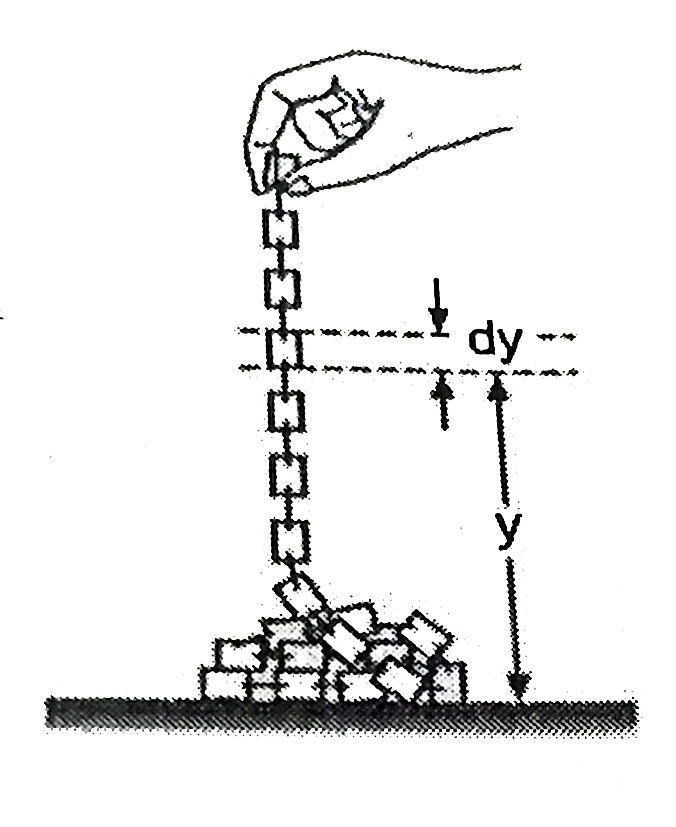A ball of clay falls to the hard floor. It does not bounce noticeably, and it very quickly comes to rest. What , then has happened to the energy the ball had while it was falling?
It has been used up in producing the downward motion.
It has been transformed back into potential energy
It has been transformed into the ball by heat.
it is in the ball and floor (and wall) as energy of invisible molecular motion.
The correct Answer is:D
The energy is internal energy .Energy is never ''usedup'' The ball finally has no elevation and no compression , so the ball - earth system has no potential energy stop there is no stove , so no energy is pu in by heat .The amount of energy transferred away by sound is minuscule.
Topper's Solved these Questions
- BOOK - A2ZCHAPTER - WORK, ENERGY, POWER AND COLLISIONEXERCISE - Mechanical Power25videos
WORK, ENERGY, POWER AND COLLISION
- BOOK - A2ZCHAPTER - WORK, ENERGY, POWER AND COLLISIONEXERCISE - Circular Motion In Vertical Plane21videos
WORK, ENERGY, POWER AND COLLISION
- BOOK - A2ZCHAPTER - WORK, ENERGY, POWER AND COLLISIONEXERCISE - Potential Energy, Conservative And Non-Conservative Forces28videos
WORK, ENERGY, POWER AND COLLISION
- BOOK - A2ZCHAPTER - WAVES AND ACOUSTICSEXERCISE - Chapter Test30videos
WAVES AND ACOUSTICS
Similar Questions
A very flexible uniform chain of mass M and length L is suspended vertically so that its lower and just touches the surface of a table. When the upper end of the chain is released it falls with each link coming to rest the instant it strikes the table. Find the force exerted by the chain on the table at the moment when y part of the chain has already rested on the table.
 View Solution
View SolutionIllustrate the law of conservation of energy by discussing the energy changes which occur when we draw a pendulum bob to one side and allow it to oscillate. Why does the bob eventually come to rest ? What happens to its energy eventually ? Is it a violation of the law of conservation of energy ?\
View Solution
Knowledge Check
- Question 1 - Select One
A ball falls vertically onto a floor with momentum p and then bounces repeatedly. If coefficient of restitution is e, then the total momentum imparted by the ball to the floor is
Ap(1+e)Bp1−eCp(1+1e)Dp(1+e1−e) - Question 2 - Select One
A ball falls vertically onto a floor with momentum p and then bounces repeatedly. If coefficient of restitution is e, then the total momentum imparted by the ball to the floor is
A(a) p(1+e)B(b) p1−eC(c) p(1−e1+e)D(d) p(1+e1−e) - Question 3 - Select One
A ball falls on the ground from a height of 10m and rebounds to a height of 8m. What is the percentage loss kinetic energy of the ball? (g=10m/s2)
A0.2B0.3C0.1D155
A Rubber Ball Rebound
A rubber ball of mass 2.0kg falls to the floor. The ball hits with a speed of 8m/s and rebounds with approximately the same speed. High speed photographs show that the ball is in contact with the floor for 10^-3s. What can we say about the force exerted on the ball by the floor?
 View Solution
View SolutionA ball is dropped from a height h onto a hard floor, from which it rebounds at very nearly its original speed. Is the process? If we consider the ball and earth as our system during what parts of the process is momentum conserved? If we use a piece of clay that falls and strikes teh floor, then what will be the answers of previous questions.
View SolutionA ball falls to the ground as shown below :

(a) What is the kinetic energy of ball when it hits the ground ?
(b) What is the potential energy of ball at B ?
(c) Which law you have made use of in answering this question ?View SolutionA rugby player runs with the ball directly toward his opponent's goal, along the positive direction of an x axis. He can legally pass the ball to a teammate as long as the ball's velocity relative to the field does not have a positive x component. Suppose the player runs at speed 3.5 m/s relative to the field while he passes the ball with velocity →vBP relative to himself. If →vBP has magnitude 6.0m/s, what is the smallest angle it can have for the pass to be legal?
View SolutionA 20kg monkey has a firm hold on a light rope that passes over a frictionless pulley and is attached to a 20cm bunch if bananas. The monkey looks upwards , sees the bananas and starts to climb the rope to get them.
(a) As the monkey climbs ,do the bananas move up , move down or remain at rest?
(b) As the monkey climbs ,does the distance between the lonkey and the banana decrease, increase or remain contact?
(c) The monkey releases her hold on the rope .What happens to the distance between the monkey and the bananas while she is falling ?
(d) Before reaching the ground , the monkey grabs the rope of stop har fall. What do the bananas do?View Solution

